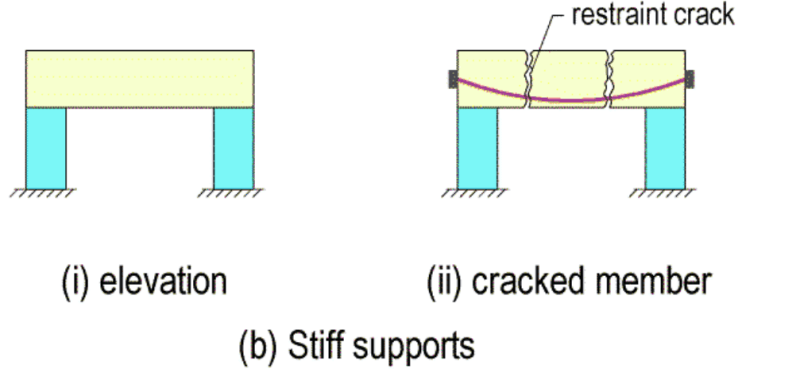I am new in PT design and a bit confused on the reasons of cracks due to restraint of stiff vertical elements in post-tension, My questions are:
1. Are the cracks a result of loss of pre-compression in the slab and diverted back to the vertical elements?or is just restraint due to drying shrinkage? or what is the difference between restraint and shrinkage cracks in PT?
2. Why does PT restraint cracks usually full depth not like normal shrinkage cracks on the surface?
3. If that is true that pre-compression is diverted back to the stiff element, then this becomes a strength issue and cannot be ignored or repaired later like shrinkage cracks.
4.In Adapt TN451 - 2 defines the restraint cracks as '' In theory, if the supports prevent any shortening (part b of the figure), the entire post-tensioning force will be diverted to the supports, leaving the member with no precompression'' if that is the case and all forces are diverted back to the supports, why would such restraint cracks happen? In my opinion the slab can fail under flexure with typical flexural cracks not as image shown below:

5. Is this statement correct: ''Force in tendon does not reduce by support restraint. In fact, it is less loss due to shrinkage of concrete. Strength is not a problem for support restraint. The problem is crack mitigation due to shrinkage of concrete''
1. Are the cracks a result of loss of pre-compression in the slab and diverted back to the vertical elements?or is just restraint due to drying shrinkage? or what is the difference between restraint and shrinkage cracks in PT?
2. Why does PT restraint cracks usually full depth not like normal shrinkage cracks on the surface?
3. If that is true that pre-compression is diverted back to the stiff element, then this becomes a strength issue and cannot be ignored or repaired later like shrinkage cracks.
4.In Adapt TN451 - 2 defines the restraint cracks as '' In theory, if the supports prevent any shortening (part b of the figure), the entire post-tensioning force will be diverted to the supports, leaving the member with no precompression'' if that is the case and all forces are diverted back to the supports, why would such restraint cracks happen? In my opinion the slab can fail under flexure with typical flexural cracks not as image shown below:

5. Is this statement correct: ''Force in tendon does not reduce by support restraint. In fact, it is less loss due to shrinkage of concrete. Strength is not a problem for support restraint. The problem is crack mitigation due to shrinkage of concrete''
